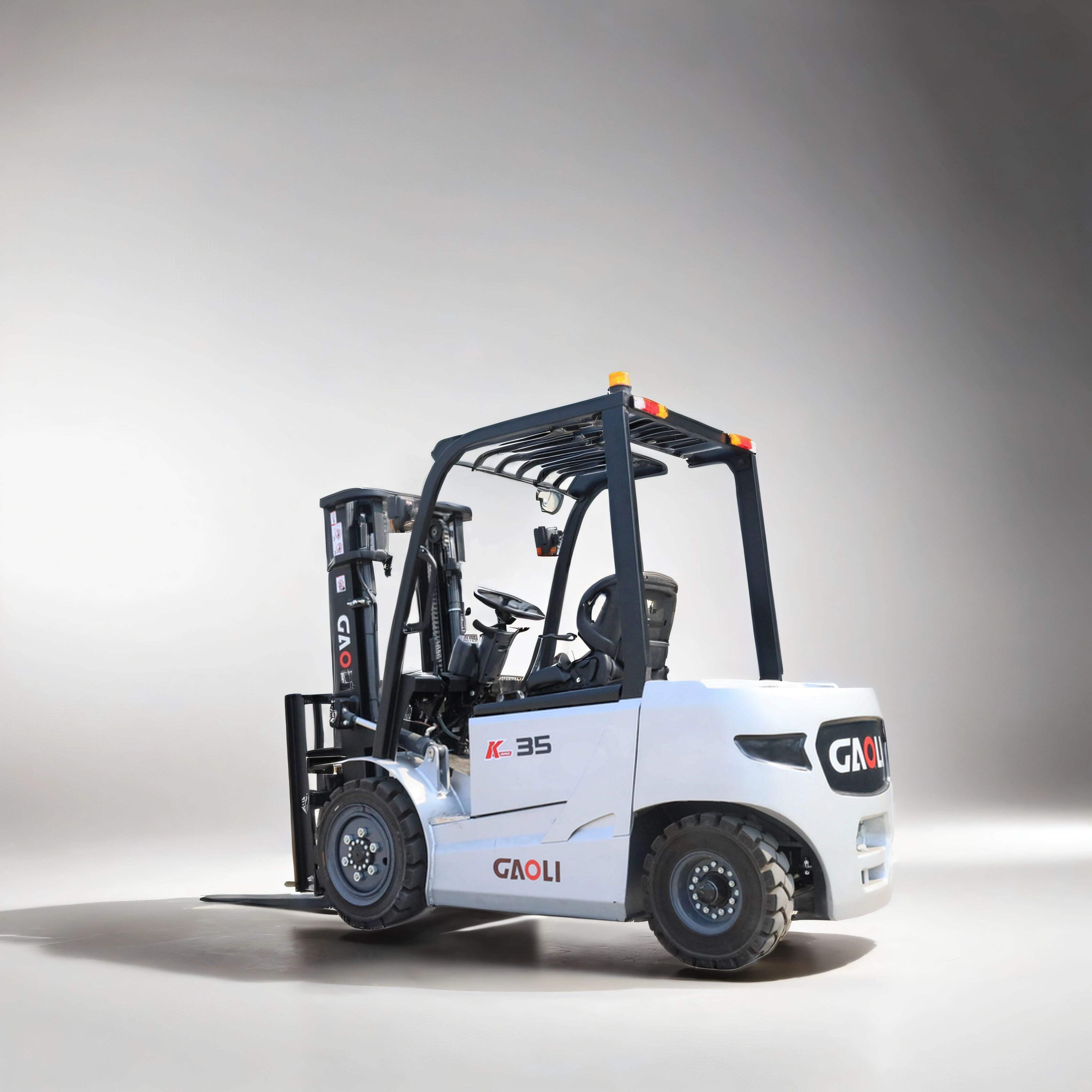Counterbalance forklift trucks offer significant advantages when it comes to handling heavy loads. Their design and functionality make them a reliable choice for maximizing lifting capacity in various industries. Understanding their benefits helps you make informed decisions about their use in your operations.
Key Features Enhancing Lifting Capacity
Counterbalance forklifts come equipped with features that directly improve their ability to handle heavy loads. One of the most notable is the counterweight at the rear of the truck. This counterweight balances the load being lifted, ensuring stability even when handling substantial weights. The design eliminates the need for additional support structures, allowing you to operate efficiently in tight spaces.
The wide tread tires on many counterbalance forklifts also play a crucial role. These tires provide a broader stance, which enhances stability during lifting and transportation. This feature becomes especially important when working on uneven surfaces or handling loads that require precise movements.
Another key feature is the straightforward operation of these forklifts. The intuitive controls and ergonomic design make it easier for operators to manage heavy loads safely. This simplicity reduces the risk of errors, helping you maintain both safety and productivity.
Advantages Over Other Forklift Types
Counterbalance forklifts stand out when compared to other types of forklifts. Their ability to handle higher lifting capacity makes them ideal for tasks involving heavy or bulky loads. Unlike reach trucks or stackers, counterbalance forklifts can lift and transport heavier weights without compromising stability.
These forklifts also excel in versatility. You can use them for a wide range of tasks, including loading and unloading trucks, stacking pallets, and moving goods across warehouses. Their adaptability ensures that you can rely on them for various operational needs.
Another advantage lies in their straightforward design. Counterbalance forklifts do not require outriggers or additional stabilizing mechanisms, which simplifies their use. This feature allows you to operate them in confined spaces without worrying about extra equipment getting in the way.
By choosing counterbalance forklifts, you gain access to a tool that combines strength, stability, and ease of use. These benefits make them an essential asset for maximizing lifting capacity in your workplace.
Factors Influencing Lifting Capacity
Understanding the factors that influence lifting capacity helps you optimize the performance of your counterbalance forklift. By addressing these elements, you can ensure safe and efficient operations while maximizing the potential of your equipment.
Load Weight and Distribution
The weight and distribution of the load directly affect the lifting capacity of your forklift. When you lift a load, its weight must remain within the forklift's rated capacity. Exceeding this limit compromises stability and increases the risk of tipping. Always check the load's weight before attempting to lift it.
Proper weight distribution is equally important. Unevenly distributed loads shift the center of gravity, making the forklift unstable. To maintain balance, position the load so that its weight is evenly spread across the forks. Centering the load ensures that the forklift operates safely and efficiently.
Forklift Design and Specifications
The design and specifications of your forklift play a crucial role in determining its lifting capacity. Each forklift model comes with a specific load capacity, which depends on factors like the size of the counterweight, the strength of the mast, and the type of tires. Familiarize yourself with your forklift's specifications to avoid overloading it.
Some forklifts feature wider tread tires, which enhance stability and allow for higher lifting capacities. The mast height also influences capacity. As the mast extends, the forklift's ability to lift heavy loads decreases. Always consult the load capacity chart provided by the manufacturer to understand how these factors impact performance.
Environmental and Operational Conditions
The environment where you operate your forklift significantly affects its lifting capacity. Uneven or slippery surfaces reduce stability, making it harder to handle heavy loads. Operating on inclines or ramps further challenges the forklift's balance. Ensure that the work area is level and free of hazards to maintain optimal performance.
Operational conditions, such as the speed of movement and turning radius, also influence lifting capacity. Rapid movements or sharp turns with a heavy load increase the risk of tipping. Train operators to move at controlled speeds and avoid sudden maneuvers to ensure safety and efficiency.
By addressing these factors, you can maximize the lifting capacity of your counterbalance forklift while maintaining a safe working environment.
Practical Tips for Maximizing Lifting Capacity
Operator Training and Certification
Proper training equips operators with the skills to handle counterbalance forklifts effectively. You should ensure that every operator completes a certified training program. These programs teach essential techniques, such as load balancing and safe maneuvering, which directly impact lifting performance. Certification also ensures compliance with workplace safety regulations, reducing the risk of accidents.
Encourage ongoing education for your operators. Regular refresher courses help them stay updated on best practices and new technologies. Skilled operators make better decisions, improving both efficiency and safety in your operations.
Regular Maintenance and Inspections
Routine maintenance keeps your forklift in optimal condition. You should schedule regular inspections to identify potential issues before they escalate. Check critical components like the mast, forks, and tires for wear and tear. Addressing these problems early prevents equipment failure and ensures consistent lifting performance.
Follow the manufacturer’s maintenance guidelines. Replace worn-out parts promptly and keep the forklift clean to avoid debris buildup. A well-maintained forklift operates more efficiently, allowing you to maximize its lifting capacity while extending its lifespan.
Proper Load Handling Techniques
Correct load handling is crucial for safe and efficient operations. Always position the load evenly on the forks to maintain balance. Uneven loads shift the center of gravity, increasing the risk of tipping. You should also ensure that the load does not exceed the forklift’s rated capacity.
When lifting, keep the load close to the mast. This reduces strain on the forklift and enhances stability. Avoid sudden movements, such as sharp turns or abrupt stops, as these can destabilize the load. By mastering proper handling techniques, you can optimize the performance of your forklift and maintain workplace safety.
Equipment Upgrades and Attachments
Enhancing your counterbalance forklift with the right upgrades and attachments can significantly boost its lifting capacity and overall performance. These modifications allow you to tailor the equipment to meet specific operational needs, making your forklift more versatile and efficient.
Fork Attachments for Specialized Tasks
Fork attachments expand the capabilities of your forklift. For example, fork extensions increase the length of the forks, enabling you to handle larger or longer loads safely. These extensions distribute the weight more evenly, reducing strain on the forklift and improving stability.
Another valuable attachment is the side shifter. This tool allows you to move the forks laterally without repositioning the entire forklift. It improves precision when placing loads and saves time during operations. You can also consider clamps, such as paper roll clamps or carton clamps, for handling non-palletized goods. These attachments make it easier to manage unique load types while maintaining safety.
Upgraded Tires for Better Stability
Tires play a crucial role in determining the stability and lifting capacity of your forklift. Upgrading to wider tread tires enhances the forklift's stance, providing better balance when lifting heavy loads. Pneumatic tires, designed for outdoor use, offer improved traction on uneven surfaces. Solid tires, on the other hand, are ideal for indoor operations and provide durability in high-use environments.
Selecting the right tires for your operational conditions ensures that your forklift performs optimally. Proper tire upgrades reduce the risk of tipping and improve the overall safety of your workplace.
Enhanced Masts and Hydraulic Systems
Upgrading the mast and hydraulic system of your forklift can increase its lifting height and capacity. A reinforced mast provides additional strength, allowing you to handle heavier loads without compromising stability. Advanced hydraulic systems improve lifting speed and precision, making your operations more efficient.
Consult the manufacturer or a certified technician before making these upgrades. Ensuring compatibility with your forklift model prevents potential issues and maximizes the benefits of the enhancements.
Safety Features for Improved Performance
Adding safety features to your forklift not only protects operators but also enhances lifting capacity. Load backrests, for instance, prevent loads from shifting backward, maintaining balance during lifting. Overhead guards shield operators from falling objects, ensuring a safer working environment.
You can also install weight indicators to monitor the load's weight in real time. These indicators help you avoid exceeding the forklift's rated capacity, reducing the risk of accidents. By prioritizing safety, you create a more reliable and efficient operation.
Choosing the Right Upgrades
When selecting upgrades and attachments, consider your specific operational needs. Evaluate the types of loads you handle, the environment where you operate, and the frequency of use. Investing in the right enhancements ensures that your forklift meets your requirements while maintaining safety and efficiency.
By upgrading your equipment and incorporating specialized attachments, you unlock the full potential of your counterbalance forklift. These improvements not only maximize lifting capacity but also streamline your operations, helping you achieve greater productivity.
Troubleshooting and Preventative Measures
Identifying and Resolving Common Issues
Counterbalance forklifts, like any machinery, can encounter operational issues. Recognizing these problems early helps you maintain efficiency and avoid costly downtime. Some common issues include hydraulic leaks, worn-out tires, and malfunctioning brakes.
To identify these problems, conduct regular visual inspections. Look for signs of wear on the tires, such as cracks or uneven tread. Check the hydraulic system for leaks or reduced fluid levels. Test the brakes to ensure they respond promptly. If you notice unusual noises or vibrations during operation, investigate immediately. These could indicate internal mechanical issues.
When resolving these issues, act quickly. Replace damaged tires to maintain stability. Repair hydraulic leaks to prevent performance loss. Address brake malfunctions to ensure safety. Always use manufacturer-approved parts and consult a certified technician for complex repairs. Prompt action keeps your forklift running smoothly and minimizes disruptions.
Preventative Maintenance for Sustained Performance
Preventative maintenance ensures your forklift operates at peak performance. By addressing potential problems before they arise, you extend the lifespan of your equipment and reduce repair costs.
Create a maintenance schedule based on the manufacturer's recommendations. Include tasks like checking fluid levels, inspecting the mast and forks, and cleaning the forklift. Regularly lubricate moving parts to reduce wear and tear. Monitor the battery or fuel system to ensure consistent power supply.
Document each maintenance activity. Keeping detailed records helps you track the condition of your forklift and identify recurring issues. This proactive approach allows you to plan repairs and replacements, avoiding unexpected breakdowns. A well-maintained forklift delivers reliable performance and maximizes lifting capacity.
Training Operators to Recognize Warning Signs
Operators play a crucial role in identifying potential issues. Training them to recognize warning signs ensures problems are addressed promptly, preventing accidents and equipment failure.
Teach operators to perform pre-operation checks. They should inspect the tires, forks, and hydraulic system before using the forklift. Encourage them to listen for unusual sounds and feel for irregular vibrations during operation. These signs often indicate underlying mechanical problems.
Provide operators with a checklist of common warning signs. Include items like fluid leaks, reduced lifting power, and difficulty steering. Train them to report these issues immediately. Prompt reporting allows you to address problems before they escalate.
Regular training sessions keep operators informed about new maintenance practices and technologies. By empowering them with knowledge, you create a safer and more efficient workplace. Skilled operators contribute to the longevity and performance of your forklift, ensuring sustained productivity.
Understanding the benefits of counterbalance forklifts and the factors that influence their performance is essential for maximizing lifting capacity. By implementing best practices, you can enhance operational efficiency and maintain workplace safety. Regular maintenance, proper training, and the use of appropriate equipment upgrades ensure your forklift operates at its full potential. Prioritizing safety and proactive care not only extends the lifespan of your equipment but also improves productivity. Apply these tips to optimize your forklift operations and achieve consistent, reliable results.


